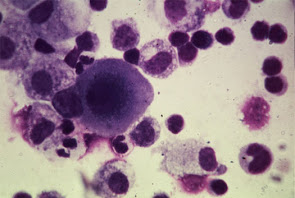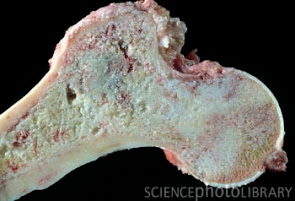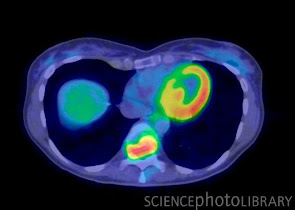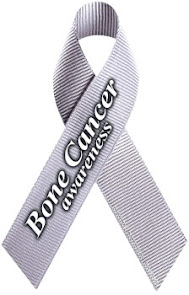Saturday 19 November 2011
What is Cancer?
What is cancer?
Cancer is a class of diseases in which abnormal cells divide uncontrollably and are able to invade other tissues. There are over 100 different type of cancer and each is classified by the name of organ or type of cell that is initially affected.
(Lanchastria,2011)
Type of cancer
The few main categories of cancer include:
· Carcinoma - cancer that begins with cells that cover external parts of body for example skin or in tissues that line internal organs. Example: lung cancer, breast cancer and colon cancer.
· Sarcoma - cancer that begins with cells in bone, cartilage, blood vessels, fat, muscle or other connective and supportive tissue.
· Leukemia - cancer that starts in blood-forming tissue such as the bone marrow and causes large numbers of abnormal blood cells to be produced and accumulate in the bloodstream.
· Lymphoma and myeloma - cancers that begin in lymph nodes and the cells of the immune system tissues.
· Central nervous system cancers - cancers that begin in the tissues of the brain and spinal cord.
· Adenomas- cancers that arise in the glandular tissues like thyroid, the pituitary gland, the adrenal gland.
Origins of Cancer
All cancers begin in cells which is the body's basic unit of life.
The body is made up of many types of cells. These cells grow and divide in a controlled way to produce more cells. When cells become old or damaged, they die and are replaced with new cells.
However, sometimes this orderly process goes wrong. The genetic material (DNA) of a cell can become damaged or changed, producing mutations that affect normal cell growth and division. When this happens, cells do not die when they should and new cells form when the body does not need them. The extra cells may form a mass of tissue called a tumor. Not all tumors are cancerous; tumors can be benign or malignant.
· Benign tumors aren't cancerous. They can often be removed, and, in most cases, they do not come back. Cells in benign tumors do not spread to other parts of the body.
· Malignant tumors are cancerous. Cells in these tumors can invade nearby tissues and spread to other parts of the body. The spread of cancer from one part of the body to another is called metastasis.
Some cancers do not form tumors. For example, leukemia is a cancer of the bone marrow and blood.
How cancer spreads
The cancer cells within malignant tumors have the ability to invade neighboring tissues and organs, thus spreading the disease. Cancer cells often break free from the tumor site and travel to the other parts of body via bloodstream or lymph vessels and begin to grow and form new tumors that replace normal tissues. This process of spreading cancer cells is called metastasis.
When cancer has metastasized and has affected other areas of the body, the disease is still referred to the organ of origination. Although most cancers develop and spread via an organ, but blood cancer like leukemia do not. They affect the blood and the organs that form blood and then invade nearby tissues.
Cancer Symptoms
Cancer symptoms are quite varied and depend on where the cancer is located, where it has spread, and how big the tumor is. . As cancer progresses to an advanced stage, common symptoms can include weight loss, fever, and fatigue. These are very non-specific symptoms that are more likely related to other less serious illnesses than cancer.
How is cancer treated?
Cancer treatment depends on the type of cancer, the stage of the cancer (how much it has spread), age, health status, and additional personal characteristics. There is no single treatment for cancer, and patients often receive a combination of therapies and palliative care. Treatments usually fall into one of the following categories: surgery, radiation, chemotherapy, immunotherapy, hormone therapy, or gene therapy.
How common is cancer?
Today, millions of people are living with cancer or have had cancer. In Malaysia, cancer is now the fourth leading cause of death among medically certified death. Among the cancer, lung cancer is the most common killer. It is estimated that the annual incidence of cancer is 30000. The risk of developing most types of cancer can be reduced by improving the quality of life of cancer, for example, by quitting smoking, limiting time in the sun, being physically active, and eating a better diet. The sooner a cancer is found and treated, the better the chances are for living for many years.
(Sarawak Hospice Society,2009)
What are bones
What are bones?
The skeletal system is vital during our lifetime. An adult human body has 206 bones. The human skeleton is a complex system and serves multiple different functions. The bones are largely made up of an organic matrix (osteoid) and the mineral calcium hydroxyapatite, which gives the bones strength and hardness.
Functions of the skeletal system:
· The bones are well adapted to provide structural support to the vertebrates. Muscles are attached to the bones and allow vertebrates to move. Without the skeletal system, the vertebrates would just become a pile of soft tissues without structure and support, and vertebrates like us will not be able to sit, stand, walk or run.
· The bones provide a protected environment for delicate internal organs. For example, the bones of the skull protect the brain, the vertebrae of the spine protect the spinal cord, and the ribs protect the heart and the lungs.
· The bones contain bone marrow that produces and stores new red blood cells and white blood cells. Red blood cells carry oxygen in the form of oxyhaemoglobin throughout the body whereas white blood cells protect our body against infections.
· The bones help to control the body’s collection of various proteins and nutrients, such as calcium and phosphorus.
What is bone cancer?
Introduction to bone cancer
Bone cancer is a sarcoma in the skeletal system. A sarcoma (originated from the Greek word “sarx” which means “flesh”) is a cancer that arises from transformed cells in one of the number of tissues that develop from the embryonic mesoderm. Two main types of cancers that are found in the bone are the primary bone cancer and the metastatic bone cancer.
Primary bone cancer, which is originated from the bone, is considerably less common than are metastatic lesions. The most common originating sites for bone metastatic are the prostate, breast, lung, kidney, gastrointestinal tract, and thyroid. The distinction between primary and metastatic bone tumours is straightforward in most cases but may be difficult in patients who present in solitary lesion without the history of a primary tumour in another site.
Bone cancers are diverse in their gross and morphological features, and vary in their natural history from innocuous to rapidly fatal. It is very critical to diagnose these cancers correctly, stage them accurately, and treat them appropriately, so that the affected patients are able to survive from the sickness, and also maintain the optimal function of the affected body parts.
In 1999, there were about 2,600 cases of primary bone cancer and about 1,400 deaths related to this disease in the United States. A great deal of progress has been made to treat bone cancer. Only about 20% of people diagnosed with osteosarcoma survived for more than five years in the year of 1972. Today, as many as 80% of those diagnosed with localized bone cancer are able to live for more than 5 years.
Types of bone cancer
PRIMARY BONE CANCER
The most common type of primary bone cancer is osteosarcoma, which is also known as osteogenic sarcoma. This type of bone cancer originates in newly forming tissues, most often in the long bones of arms and legs. The second common type of bone cancer is chondrosarcoma, tumors made of abnormal cartilage. Ewing’s sarcoma is the third most frequent diagnosed bone cancer. This type of bone cancer believed to originate in immature nerve tissues. Ewing’s sarcoma is the most common bone cancer that affects children and teenagers. Other forms of bone cancer include chordoma, malignant giant cell tumor, adamantinoma, and reticulum cell sarcoma juxtacortical osteosarcoma.
| Type of bone cancer | Common locations | Ages that will be affected (years) | Tissue of origin |
| Primary osteosarcoma | Metaphysis of distal femur, proximal tibia, and humerus. | 10 - 20 | Osteoid (bone) |
| Secondary osteosarcoma | Femur, humerus, and pelvis | > 40 | Osteoid (bone) |
| Chondrosarcoma | Bones of shoulders, pelvis, proximal femur, and ribs. | 40 – 60 | Cartilage |
| Ewing’s sarcoma | Leg, hip, and arms. | 10 – 20 | Immature nerve tissues, usually in bone marrow |
| Chordoma | Upper/lower ends of spinal column or skull. | 55 – 65 | Cellular remnants of fetal spinal cords |
| Malignant giant cell tumor | Knee and vertebra. | 40 – 55 | Connective tissues of bone marrow |
| Fibrosarcoma of bone | Leg, hip, and arms | 30 – 40 | Connective tissues within bone marrow cavity |
(a) Osteosarcoma
Osteosarcoma is a malignant mesenchymal tumor in which the cancerous cells produce bone matrix. Exclusive of myeloma and lymphoma, osteosarcoma is the most common primary malignant tumor of bone that causes bone cancer. Osteosarcoma accounts for approximately 20% of primary bone cancers. Osteosarcoma occurs in all age groups. However, it has a bimodal age distribution: 75% occur in persons younger than 20 years old. The smaller second peak occurs in the elderly (over 60 years old). In 50% of this group, Paget’s disease (conditions known to predispose to osteosarcoma) is associated. Overall, men are more commonly affected than women with ratio 1.6 : 1.
(b) Chondrosarcoma
Chondrosarcomas are a group of tumors that span a broad spectrum of clinical and pathologic findings. Chondrosarcoma of the skeleton is about half as frequent as osteosarcoma and is the second most common malignant matrix-producing of bone. Unlike cartilage-forming osteosarcomas, the neoplastic cells in chondrosarcomas do not form osteoid. Futhermore, as compared with osteosarcomas, chondrosarcomas occur in older patients, usually in their 40s or older. Males are affected about twice as frequent as females. Chondrosarcomas commonly arise in the central portions of the skeleton, including the pelvis, shoulders, and ribs.
(c) Ewing’s sarcoma
The Ewing sarcoma family of tumors encompasses the well-known Ewing sarcoma (EWS) of the bone, extraosseous EWS, primitive neuroectodermal tumor (PNET), neuroepithelioma, and Askin tumor. Among these, EWS and PNET are the most common, and they account for 6% to 10% of all primary bone tumors. Of all bone sarcomas, EWS/PNET has the youngest average age at presentation. Most affected individuals are between 10 to 15 years old, and approximately 80% are younger than 20 years old. Boys are affected slightly more frequently than girls.
(d) Chordoma
Chordoma is a very rare type of tumor with an average survival of about six years after diagnosis. Chordoma occurs in adults over 30 years of age and is about twice as common in males as in females. It commonly affects either the lower or upper ends of the spinal column or skull.
(e) Malignant giant cell tumor
Giant cell tumor is so named because it contains a mixture of mononuclear cells and a profusion of multinucleated osteoclast type giant cell. Giant cell tumor of bone is also known as osteoclastoma. Most cases arise in the epiphyses of long bones, particularly the distal femur, proximal tibia, proximal humerus and distal radius, and the vertebrae. It usually arises in individuals in their 40s, with slight female predominance. The histological of the giant cell tumor is incompletely understood. Current opinions suggest that the giant cell component is likely a reactive cell population derived from macrophages and only the accompanying mononuclear cells are neoplastic.
(f) Fibrosarcoma
Fibrosarcoma is a much more rare bone cancer as compared to the others. It mostly affects individuals in their 30s to 40s, and is slightly more common in males than in females. Fibrosarcoma mainly affects the soft tissues of leg, behind the knees, hip, and arms.
SECONDARY BONE CANCER
Metastases are usually multiple, occasionally latent renal and thyroid cancers present as a single bony metastasis with pathological fracture. The incidence of bone secondaries especially in the spine is very high when these tumors become wide spread. Metastases are usually osteolytic with extensive destruction of bone. Osteoblastic activity is stimulated by the presence of tumor so that the dense reactive bone is formed in minority of the cases. Osteosclerotic secondaries of this type are seen particularly in cancers of the prostate and breast.
OTHER CANCER THAT DEVELOPS IN THE BONE
(a) Non-Hodgkin lymphoma
Non-Hodgkin lymphoma usually develops in the lymph nodes but sometimes start in the bone. Primary non-Hodgkin lymphoma of the bone is often a widespread disease. This is because multiple sites of the body are involved. The outlook is about the same to other non-Hodgkin lymphomas of the same subtype and stage. Primary lymphoma of the bone is given the same treatment as lymphomas that are started in lymph nodes.
(b) Multiple myeloma
Multiple myeloma is almost always found in the bones. However, doctors do not consider it as a primary bone cancer because multiple myeloma develops from the plasma cells of the bone marrows. Although it causes bone destruction, it is no more a bone cancer than is leukaemia. Multiple myeloma is treated as a widespread disease. Sometimes, myeloma can be first found as a single tumour, called plasmacytoma, in a single bone, but most of the times, it will go on to spread to the marrow of other bones.
Which part of the body does bone cancer affect?
Bone cancers are rare forms of cancers that can affect any bone in the body. There are 2 types of bone cancers namely bone sarcomas and multiple myeloma. Bone cancers can also happen when tumours start in other organs. This is known as secondary bone cancer.
Bone cancer may cause some disturbance to the production of blood cells in the bone marrow.
What are the symptoms of bone cancer?
What are the symptoms of bone cancer?
Bone cancer symptoms tend to develop slowly. These symptoms depend on the type, location, and the size of the tumor.
Symptoms:
· Bone pain: The pain often comes and goes at first. It tends to become worse at night, and it may be better with movements. Later on, it is there all the time and may be worse during activities. The bone might be so weak and causes fracture.
· Sometimes, a firm, slightly tender lump on the bone can be felt through the skin.
· Problems with movements.
· Bone fractures: Bones can break, and this causes sudden, severe pain and keeps you from moving. The bones that are more likely to break are the long bones of the arms and legs, and the bones of the spine. Sudden pain in the middle of the back is sometimes a sign of bone breaking.
However, these symptoms are not sure signs of bone cancer. They might be caused by other less serious problems. Individuals who are experiencing these symptoms should consult a doctor.
Other signs of bone cancer include:
· Swelling of joints and tenderness for tumors in or near joints.
· Fatigue
· Fever
· Unintentionally weight loss
· Anaemia
Secondary bone cancer symptoms:
· Chronic pain in the afflicted area.
· Bones are weakened, often leads to pathological fractures.
· Bone fractures that occur as a result of the fragility of the bones, not because of the external forces.
· Pressure on the spinal cord: Cancer growth in the back bones can press on the spinal cord. This is a serious problem as it does not only cause pain, but the pressure can cause damage to the spinal cord. The arms and legs might become numb or even paralyzed. The first symptom of this problem is trouble passing urine because nerves from the spinal cord control the bladder.
· High blood calcium (hypercalcemia): High levels of calcium in the blood are caused by release of calcium form bones. This can cause loss of appetite, nausea, extreme thirst, confusion, and fatigue. It might lead to coma if it is not treated.
· Anaemia and increased susceptibility to infection as cancer cells invade further into the bone and hamper the bone marrow to manufacture blood cells. Therefore, reducing the overall body resistance.
Subscribe to:
Posts (Atom)






















